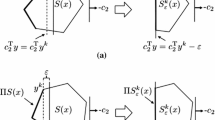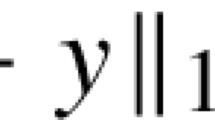Abstract
We consider a class of bilevel linear mixed-integer programs (BMIPs), where the follower’s optimization problem is a linear program. A typical assumption in the literature for BMIPs is that the follower responds to the leader optimally, i.e., the lower-level problem is solved to optimality for a given leader’s decision. However, this assumption may be violated in adversarial settings, where the follower may be willing to give up a portion of his/her optimal objective function value, and thus select a suboptimal solution, in order to inflict more damage to the leader. To handle such adversarial settings we consider a modeling approach referred to as \(\alpha \)-pessimistic BMIPs. The proposed method naturally encompasses as its special classes pessimistic BMIPs and max–min (or min–max) problems. Furthermore, we extend this new modeling approach by considering strong-weak bilevel programs, where the leader is not certain if the follower is collaborative or adversarial, and thus attempts to make a decision by taking into account both cases via a convex combination of the corresponding objective function values. We study basic properties of the proposed models and provide numerical examples with a class of the defender–attacker problems to illustrate the derived results. We also consider some related computational complexity issues, in particular, with respect to optimistic and pessimistic bilevel linear programs.





Similar content being viewed by others
Notes
In the remainder of the paper we use “her” and “his” whenever we refer to the leader and the follower, respectively.
References
Aboussoror, A., Loridan, P.: Strong–weak stackelberg problems in finite dimensional spaces. Serdica Math. J. 21(2), 151–170 (1995)
Audet, C., Haddad, J., Savard, G.: Disjunctive cuts for continuous linear bilevel programming. Optim. Lett. 1(3), 259–267 (2007)
Audet, C., Hansen, P., Jaumard, B., Savard, G.: Links between linear bilevel and mixed 0–1 programming problems. J. Optim. Theory Appl. 93(2), 273–300 (1997)
Audet, C., Savard, G., Zghal, W.: New branch-and-cut algorithm for bilevel linear programming. J. Optim. Theory Appl. 134(2), 353–370 (2007)
Bard, J.F.: Practical Bilevel Optimization: Algorithms and Applications. Nonconvex Optimization and its Applications. Kluwer Academic Publishers, Dordrecht (1998)
Bard, J.F., Plummer, J., Sourie, J.C.: A bilevel programming approach to determining tax credits for biofuel production. Eur. J. Oper. Res. 120(1), 30–46 (2000)
Bayrak, H., Bailey, M.D.: Shortest path network interdiction with asymmetric information. Networks 52(3), 133–140 (2008)
Brown, G., Carlyle, M., Salmeron, J., Wood, K.: Defending critical infrastructure. Interfaces 36(6), 530–544 (2006)
Burgard, A.P., Pharkya, P., Maranas, C.D.: Optknock: a bilevel programming framework for identifying gene knockout strategies for microbial strain optimization. Biotechnol. Bioeng. 84(6), 647–657 (2003)
Cao, D., Leung, L.C.: A partial cooperation model for non-unique linear two-level decision problems. Eur. J. Oper. Res. 140(1), 134–141 (2002)
Caramia, M., Mari, R.: Enhanced exact algorithms for discrete bilevel linear problems. Optim. Lett. 9(7), 1447–1468 (2015)
Chiou, S.-W.: Bilevel programming for the continuous transport network design problem. Transp. Res. B 39(4), 361–383 (2005)
Colson, B., Marcotte, P., Savard, G.: An overview of bilevel optimization. Ann. Oper. Res. 153(1), 235–256 (2007)
Côté, J.-P., Savard, G.: A bilevel modelling approach to pricing and fare optimization in the airline industry. J. Revenue Pricing Manag. 2(1), 23–26 (2003)
Dempe, S.: Foundations of Bilevel Programming. Kluwer Academic Publishers, Dordrecht (2002)
Dempe, S., Mordukhovich, B.S., Zemkoho, A.B.: Sensitivity analysis for two-level value functions with applications to bilevel programming. SIAM J. Optim. 22(4), 1309–1343 (2012)
DeNegre, S., and Ralphs, T.K.: A branch-and-cut algorithm for bilevel integer programming. In: Proceedings of the Eleventh INFORMS Computing Society Meeting, pp. 65–78 (2009)
Deng, X.: Complexity issues in bilevel linear programming. In: Multilevel Optimization: Algorithms and Applications, pp. 149–164. Springer, Berlin (1998)
Garey, M.R., Johnson, D.S.: Computers and Intractability: A Guide to the Theory of NP-Completeness. W.H. Freeman, San Francisco (1979)
Gzara, F.: A cutting plane approach for bilevel hazardous material transport network design. Oper. Res. Lett. 41(1), 40–46 (2013)
Hansen, P., Jaumard, B., Savard, G.: New branch-and-bound rules for linear bilevel programming. SIAM J. Sci. Stat. Comput. 13(5), 1194–1217 (1992)
Horst, R., Pardalos, P.M.: Handbook of Global Optimization. Kluwer Academic Publishers, Dordrecht (1994)
IBM ILOG CPLEX. http://www-01.ibm.com/software/info/ilog/ (2016). Accessed on 7 Jan 2016
Israeli, E., Wood, R.: Shortest-path network interdiction. Networks 40(2), 97–111 (2002)
Mallozzi, L., Morgan, J.: \(\varepsilon \)-mixed strategies for static continuous-kernel Stackelberg games. J. Optim. Theory Appl. 78(2), 303–316 (1993)
Migdalas, A.: Bilevel programming in traffic planning: models, methods and challenge. J. Global Optim. 7(4), 381–405 (1995)
Migdalas, A., Pardalos, P.M., Värbrand, P.: Multilevel Optimization: Algorithms and Applications. Kluwer Academic Publishers, Norwell (1998)
Patriksson, M., Rockafellar, R.T.: A mathematical model and descent algorithm for bilevel traffic management. Transp. Sci. 36(3), 271–291 (2002)
Ren, S., Zeng, B., Qian, X.: Adaptive bilevel programming for optimal gene knockouts for targeted overproduction under phenotypic constraints. BMC Bioinform. 14(Suppl 2), S17 (2013)
Shen, S., Smith, J.C., Goli, R.: Exact interdiction models and algorithms for disconnecting networks via node deletions. Discrete Optim. 9(3), 172–188 (2012)
Stackelberg, H.: The Theory of Market Economy. Oxford University Press, Oxford (1952)
Steeger, G., Barroso, L.A., Rebennack, S.: Optimal bidding strategies for hydro-electric producers: a literature survey. IEEE Trans. Power Syst. 29(4), 1758–1766 (2014)
Steeger, G., Rebennack, S.: Strategic bidding for multiple price-maker hydroelectric producers. IIE Trans. 47(9), 1013–1031 (2015)
Tang, Y., Richard, J.-P.P., Smith, J.C.: A class of algorithms for mixed-integer bilevel min-max optimization. J. Glob. Optim. 66(2), 225–262 (2016)
Vazirani, V.: Approximation Algorithms. Springer, Berlin (2013)
Wood, R.: Deterministic network interdiction. Math. Comput. Model. 17(2), 1–18 (1993)
Xin, C., Qingge, L., Wang, J., Zhu, B.: Robust optimization for the hazardous materials transportation network design problem. J. Comb. Optim. 30(2), 320–334 (2015)
Zeng, B.: Easier than we thought—a practical scheme to compute pessimistic bilevel optimization problem. SSRN: http://ssrn.com/abstract=2658342. (2015). 9 Aug 2015
Zheng, Y., Wan, Z., Jia, S., Wang, G.: A new method for strong-weak linear bilevel programming problem. J. Ind. Manag. Optim. 11(2), 529–547 (2015)
Acknowledgements
This material is based upon work partially supported by the National Science Foundation [Grants CMMI-1400009 and CMMI-1634835], DoD DURIP Grant FA2386-12-1-3032, the Air Force Research Laboratory (AFRL) Mathematical Modeling and Optimization Institute and the Air Force Office of Scientific Research (AFOSR). The authors thank two anonymous referees and the Associate Editor for their constructive and helpful comments.
Author information
Authors and Affiliations
Corresponding author
Rights and permissions
About this article
Cite this article
Zare, M.H., Özaltın, O.Y. & Prokopyev, O.A. On a class of bilevel linear mixed-integer programs in adversarial settings. J Glob Optim 71, 91–113 (2018). https://doi.org/10.1007/s10898-017-0549-2
Received:
Accepted:
Published:
Issue Date:
DOI: https://doi.org/10.1007/s10898-017-0549-2




